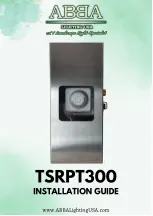
TK-3230
2
ADJUSTMENT
Required Test Equipment
1. Stabilized Power Supply
1) The supply voltage can be changed between 0V and 10V,
and the current is 3A or more
2) The standard voltage is 3.8V
2. DC Ammeter
1) Class 1 ammeter (17 ranges and other features).
2) The full scale can be set to either 300mA or 3A.
3) A cable of less internal loss must be used.
3. Frequency Counter (f. counter)
1) Frequencies of up to 1GHz or so can be measured.
2) The sensitivity can be changed to 500MHz or below, and
measurements are highly stable and accurate (0.2ppm or so).
4. Power Meter
1) Measurable frequency : Up to 600MHz
2) Impedance : 50
Ω
, unbalanced
3) Measuring range : Full scale of 3W or so
4) A standard cable (5D2W 1m) must be used.
5. RF Voltmeter (RF V.M)
1) Measurable frequency : Up to 600MHz or so
6. Linear Detector
1) Measurable frequency : Up to 600MHz or so
2) Characteristics are fl at, and CN is 60dB or more
7. Digital Voltmeter
1) Voltage range : FS=10V or so
2) Input resistance : 1M
Ω
or more
8. Oscilloscope
1) Measuring range : DC to 30MHz
2) Provides highly accurate measurements for 5 to 25MHz.
9. AF Voltmeter (AF V.M)
1) Measurable frequency : 50Hz to 1MHz
2) Maximum sensitivity : 1mV or more
10. Standard Signal Generator (SSG)
1) Maximum frequency : 600MHz or more
2) Output : –133dBm/0.05µV to 7dBm/501mV
3) Output impedance : 50
Ω
11. Dummy Load
1) 8
Ω
, 1W or more
12. AF Generator (AG)
1) Frequency range : 100Hz to 100kHz
2) Output : 0.5mV to 1V
13. Distortion Meter
1) Measurable frequency : 30Hz to 100kHz
2) Input level : 50mV to 10Vrms
Service Jig
■
ANT cable (E30-3418-08)
Modify the cable as shown below.
Cut
Solder the ANT cable to the ANT terminal on the TX-RX
unit.
GND
ANT
terminal
TX-RX unit
ANT cable
■
Battery jig (W05-1365-00)
Connect the power cable properly between the battery
jig installed in the transceiver and the power supply, and
be sure output voltage and the power supply polarity prior
to switching the power supply ON, otherwise over voltage
and reverse connection may damage the transceiver, or the
power supply or both.
Note:
When using the battery jig, you must measure the
voltage at the terminals of the battery jig. Otherwise, a
slight voltage drop may occur within the power cable,
between the power supply and the battery jig, especially
while the transceiver transmits.
Test Signaling
No.
Receive
Transmit
1
None
None
2
None
100Hz Square Wave
3
QT 67.0Hz
QT 67.0Hz
4
QT 151.4Hz
QT 151.4Hz
5
QT 250.3Hz
QT 250.3Hz
6
DQT D023N
DQT D023N
7
DQT D754I
DQT D754I
8
MSK Code (100-1000)
MSK Code (100-1000)
9
None
MSK (1010…)
Test Frequency
No.
Receive (MHz)
Transmit (MHz)
1 (Low)
460.05000
460.10000
2 (High)
469.95000
469.90000
3
460.00000 460.00000
4
460.20000 460.20000
5
460.40000 460.40000
6
460.60000 460.60000
Adjustment Frequency List
CH
Receive (MHz)
Transmit (MHz)
Center
465.05000 465.00000
Frequency Shift 6.25kHz
-
465.00625
Frequency Shift 5.kHz
-
465.00500
























